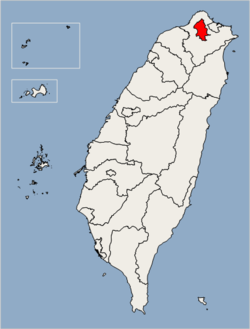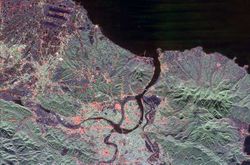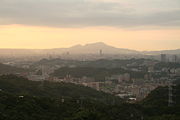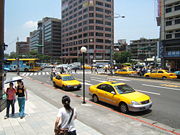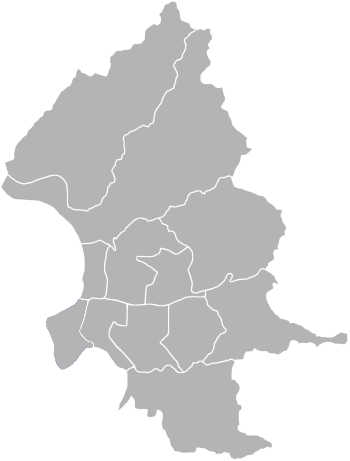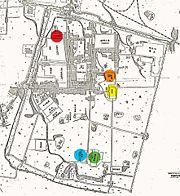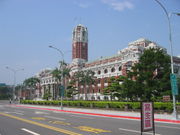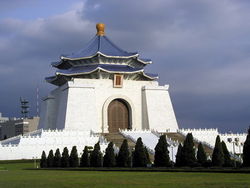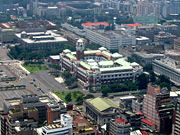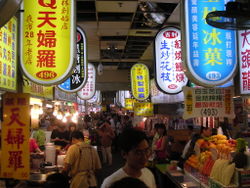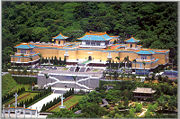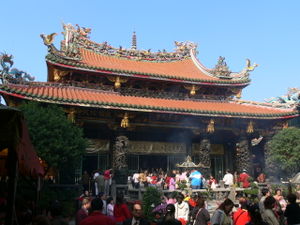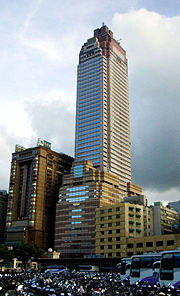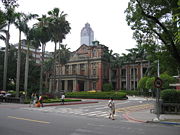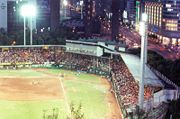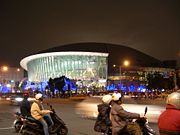Taipei
2008/9 Schools Wikipedia Selection. Related subjects: Asia; Asian Cities
| Taipei City 臺北市 |
|||
| Taipei City | |||
|
|||
| Nickname: the City of Azaleas (杜鵑花之城) | |||
| Satellite image of Taipei City | |||
| Coordinates: | |||
|---|---|---|---|
| Country | |||
| Region | Northern Taiwan | ||
| City seat | Xinyi District (信義區) | ||
| Government | |||
| - Mayor | Hau Lung-bin ( KMT) | ||
| Area | |||
| - City | 271.7997 km² (104.9 sq mi) | ||
| - Water | 2.7 km² (1.0 sq mi) 1.0% | ||
| - Urban | 2,457 km² (948.7 sq mi) | ||
| Population (May 2008) | |||
| - City | 2,630,515 | ||
| - Density | 9,678.14 /km² (25,031/sq mi) | ||
| - Urban | 6,752,826 | ||
| - Metro | 10,072,918 | ||
| Population Ranked 2 of 25 | |||
| Time zone | CST ( UTC+8) | ||
| The city has 12 districts. The metropolitan area of Taipei includes Taipei City, Taipei County, Keelung City, Taoyuan County, Hsinchu City, Hsinchu County, and Yilan County. City flower: Azalea (Rhododendron nudiflorum) City tree: Banyan (India laurel fig, Ficus microcarpa) City bird: Formosan Blue Magpie (Urocissa caerulea) |
|||
| Website: http://english.taipei.gov.tw/TCG/index.jsp | |||
Taipei ( traditional Chinese: 臺北市 or 台北市; simplified Chinese: 台北市; Hanyu Pinyin: Táiběi Shì; Tongyong Pinyin: Táiběi Shìh, Taiwanese Pe̍h-ōe-jī: Tâi-pak-chhī; Zhuyin Fuhao: ㄊㄞˊ ㄅㄟˇ ㄕˋ) has been the capital of the Republic of China (ROC) on Taiwan since 1949 and is the largest city in Taiwan. It is situated on the Danshui (Danshuei) River, almost at the northern tip of the country, about 25 km southwest of Keelung, which is its port on the Pacific Ocean. Another coastal city, Danshui, is about 20 km northwest at the river's mouth on the Taiwan Strait.
Taipei lies in the relatively narrow, bowl-shaped valley of the Danshui and two of its main tributaries, the Keelung and Xindian (Sindian) rivers. The generally low-lying terrain of the central areas on the western side of the municipality slopes upward to the south and east and especially to the north, where it reaches 1,120 metres at Mount Qixing (七星山). The climate is humid subtropical, with hot, muggy, rainy summers and cool, damp winters. It is also the political, economic, and cultural centre of the country.
Taipei City, the Taipei County, and the nearby Keelung City together form the Taipei metropolitan area but are administered under different local government bodies. Taipei City is a special municipality administered directly under the Executive Yuan, while Taipei County and Keelung City are administered as part of Taiwan Province. Taipei commonly refers to the whole metropolitan area, while Taipei City refers to the city proper. Taipei's city government is headed by a mayor who is appointed by the president of the republic on recommendation of the premier. A secretary-general assists the mayor.
The National Palace Museum on the outskirts of the city houses one of the world's largest collections of ancient Chinese artifacts, calligraphy, paintings, and porcelain. The National Chiang Kai-shek Memorial Hall is an impressive monument built in classical Chinese style. The Longshan Temple — dedicated to Guan Yin, the Buddhist Bodhisattva of Mercy — is considered the best example of temple architecture in Taiwan.
A popular recreation area is nearby Yangmingshan (陽明山). Both the mountain and the town of Beitou at its base are known for their hot springs. Bitan (Green Lake) has boating and water sports. There are ocean beaches nearby.
Taipei is part of a major industrial area. Most of Taiwan's textile factories are here, and other products include electronics, electrical machinery and appliances, wires and cables, and refrigeration equipment. Shipbuilding, including yachts and other pleasure craft, is done in the port of Keelung east of the city. Railways and bus lines connect Taipei with all parts of the island. The city is served by the Taiwan Taoyuan International Airport west of the city in Taoyuan. The freeway system is excellent.
Taipei was founded in the early 18th century and became an important centre for overseas trade in the 19th century. The Japanese acquired the island in 1895 after the Sino-Japanese War and made Taipei the capital. The Republic of China took over the island in 1945 after Japan's defeat in World War II. The city became the provisional capital of the Kuomintang (KMT) government in December 1949 after the Communist government was formally installed in mainland China.
Romanization
The spelling Taipei derives from the Wade-Giles romanization T'ai-pei, which is pronounced IPA: /'taɪ'pe/ (rhyming with "spay") by English speakers.
Hanyu Pinyin, which is mandated by the KMT Taipei City government, and Tongyong Pinyin, which is mandated by the DPP central government, both reflect this pronunciation, romanizing Taipei as Taibei, a spelling that is closer to the Standard Mandarin pronunciation of IPA: /'tʰaɪ'peɪ/. However, this romanization is very rarely seen.
Taipei City has converted many of its street signs to Hanyu Pinyin, but it has retained the original spelling of "Taipei" as an exception, since this form has been well-known and heavily used.
Geography
Taipei City is located in the Taipei Basin in northern Taiwan. It is bordered by the Xindian River on the south, and the Danshui (Tamsui) River on the west. The northern districts of Shilin and Beitou extend north of the Keelung River and are bordered by Yangmingshan National Park. The Taipei city limits cover an area ranked sixteenth of twenty-five among all counties and cities in Taiwan.
Cising Mountain is located on the Datun Volcano Group and the tallest Mountain at the rim of the Taipei Basin. Its main peak is 1,120 m tall (above elevation).
Mt. Datun's main peak is 1092 m tall. It is defined as an area in the western section of Yangmingshan National Park, extending from Mt. Datun northward to Mt. Caigongkeng (菜公坑山). Located on a broad saddle between two mountains, the area contains the marshy Datun Pond.
Administrative divisions
Taipei City administers twelve districts (區):
| Hanyu Pinyin | Chinese characters (Hanzi) | Wade-Giles |
|---|---|---|
| Sōngshān | 松山區 | Sung-shan |
| Xìnyì | 信義區 | Hsin-yi |
| Dà'ān | 大安區 | Ta-an |
| Zhōngshān | 中山區 | Chung-shan |
| Zhōngzhèng | 中正區 | Chung-cheng |
| Dàtóng | 大同區 | Ta-t'ung |
| Wànhuá | 萬華區 | Wan-hua |
| Wénshān | 文山區 | Wen-shan |
| Nángǎng | 南港區 | Nan-kang |
| Nèihú | 內湖區 | Nei-hu |
| Shìlín | 士林區 | Shih-lin |
| Běitóu | 北投區 | Pei-t'ou |
Climate
The average annual temperature is 23.6 °C (74.5 °F), with a summer average of 29.4 °C (84.9 °F) and a winter average of 11.0 °C (51.8 °F). The pacific typhoon season occurs between June and October.
History
The region known as the Taipei basin was home to Ketagalan tribes before the eighteenth century. Han Chinese mainly from Fujian province of China began to settle in the Taipei Basin in 1709. In the late 19th century, the Taipei area, where the major Han Chinese settlements in northern Taiwan and one of the designated overseas trade port, Tamsui, were located, gained economic importance due to the booming overseas trade, especially that of tea exportation. In 1875, the northern part of Taiwan was separated from Taiwan Prefecture (臺灣府) and incorporated into the new Taipei Prefecture as a new administrative entity of the Chinese government (Qing Dynasty). Having been established adjoining the flourishing townships of Bangkah and Twatutia, the new prefectural capital was known as Chengnei (城內), "the inner city", and government buildings were erected there. From 1875 (during the Qing Dynasty) until the beginning of Japanese rule in 1895, Taipei was part of Danshui County of Taipei Prefecture and the prefectural capital. In 1886, when Taiwan was proclaimed a province of China, Taipei city was made the provincial capital. Taipei remained a temporary provincial capital before it officially became the capital of Taiwan in 1894. All that remains from the old Qing Dynasty city is the north gate. The west gate and city walls were demolished by the Japanese while the south gate, little south gate and east gate were extensively modified by the Kuomintang and have lost much of their original character.
As settlement for losing the First Sino-Japanese War, China ceded the island of Taiwan to the Empire of Japan in 1895 as part of the peace agreement. After the Japanese take-over, Taipei, called Taihoku in Japanese, was retained as the capital and emerged as the political center of the Japanese Colonial Government. During that time the city acquired the characteristics of an administrative centre, including many new public buildings and housing for civil servants. Much of the architecture of Taipei dates from the period of Japanese rule, including the Presidential Building which was the Office of the Taiwan Governor-General.
During the Japanese rule, Taihoku was incorporated in 1920 as part of Taihoku Prefecture (台北縣). It included Bangka, Dadaocheng, and Chengnei among other small settlements. The eastern village Matsuyama (松山區) was annexed into Taihoku City in 1938. Upon the Japanese defeat in the Pacific War and its consequent surrender in August 1945, the Chinese Nationalist assumed control of Taiwan. Subsequently, a temporary Office of the Taiwan Province Administrative Governor was established in Taipei City.
On December 7, 1949, the Kuomintang (KMT) government under Chiang Kai-shek established Taipei as the capital of the ROC after the Communists forced them to flee mainland China after the Civil War.
Taipei expanded greatly in the decades after 1949, and as approved on December 30, 1966 by the Executive Yuan, Taipei was declared a special centrally administered municipality on July 1, 1967 and given the administrative status of a province. In the following year, Taipei City expanded again by annexing Shilin, Beitou, Neihu, Nangang, Jingmei, and Muzha. At that time, the city's total area increased fourfold through absorbing several outlying towns and villages.
The city's population, which had reached one million in the early 1960s, also expanded rapidly after 1967, exceeding two million by the mid-1970s. Although growth within the city itself gradually slowed thereafter — its population had become relatively stable by the mid-1990s — Taipei remained one of the world's most densely populated urban areas, and the population continued to increase in the region surrounding the city, notably along the corridor between Taipei and Keelung. In 1990, 16 districts in Taipei City were consolidated into the current 12 districts.
Economy
As the capital of Taiwan, Taipei has been at the centre of rapid economic development in the country and has now become one of the global cities in the production of high technology and its components. This is part of the so called Taiwan miracle which has seen dramatic growth in the city following foreign direct investment in the 1960s. Taiwan is now a creditor economy, holding one of the world's largest foreign exchange reserves of more than $500 billion (100 G$) in 1999. Despite the Asian financial crisis, the economy continues to expand at about 5% per year, with virtually full employment and low inflation.
Taipei and its environs have long been the foremost industrial area of Taiwan. Most of the country's important factories producing textiles and wearing apparel are located there; other industries include the manufacture of electronic products and components, electrical machinery and equipment, printed materials, precision equipment, and foods and beverages. Services, including those related to commerce, transportation, and banking, have become increasingly important. Tourism is a small but significant component of the local economy.
Beginning in the 1960s, many older, low wooden buildings in Taipei began to be replaced with high-rise apartment houses and office buildings. Because of the population influx and the priority given to office and industrial construction, an acute shortage of housing developed in the city. The government has taken steps since the late 1960s to build affordable public housing, but overall real-estate costs have remained high. Much new construction has occurred in the city centre, particularly in the area of the Presidential Building and the Nationalist Party headquarters, and broad boulevards now radiate from there to all parts of the city. Among the more notable commercial projects was the Taipei 101 (Taipei Financial Centre) building which, when its framework was completed in 2003, became the world's tallest building, reaching 508 m.
In the 1960s, foreign investment in Taiwan helped introduce modern, labor-intensive technology to the island, and Taiwan became a major exporter of labor-intensive products.
On July 1, 1970, to further develop Taiwan international trade activities, Taiwan External Trade Development Council (TAITRA) were established as economic growth was accelerating. The Taipei World Trade Centre was completed in 1985.
In the 1980s, production in Taiwan shifted toward increasingly sophisticated, capital-intensive and technology-intensive products for export and toward developing the service sector. At the same time, the appreciation of the New Taiwan dollar (TWD), rising labor costs, and increasing environmental consciousness in Taiwan caused many labor-intensive industries, such as shoe manufacturing, to move to mainland China. Taiwan has also invested heavily in mainland China estimated to total more than $100 billion.
However the Taiwan External Trade Development Council (TAITRA), was established in 1986 to provide a single, modern venue that would combine exhibition space, conference facilities, offices, and hotel accommodation for international business. Its located in the city's Xinyi District, TWTC combines every possible service that brings together a vast consulting service on trade-related issues, trading partners, suppliers, and markets.
The International Trade Building was completed in 1988 and the International Convention Centre completed in 1989.
Government
The current mayor of Taipei City is Hau Lung-bin who won the 2006 mayoral election on December 9, 2006.
The mayor of Taipei City had been an appointed position since Taipei's conversion to a centrally-administered municipality in 1967 until the first public election was held in 1994. The position has a four-year term. The first elected mayor was Chen Shui-bian of the Democratic Progressive Party (民主進步黨; DPP). Ma Ying-Jeou took office in 1998 for two terms, before handing over to Hau Lung-bin. Both Chen Shui-bian and Ma Ying-Jeou went on to become President of Taiwan.
Based on the outcomes of previous elections in the past decade, the vote of the overall constituency of Taipei City shows a slight inclination towards the pro-KMT camp (the Pan-Blue Coalition); however, the pro-DPP camp (the Pan-Green Coalition) also has considerable support.
Ketagalan Boulevard, where Taiwan's Presidential Office Building and other government structures are situated, is often the site of mass gatherings such as inauguration and national holiday parades, receptions for visiting dignitaries, political demonstrations and public festivals.
Landmarks and attractions
Most areas of interest are easily accessible from the transit system. The MRT (Taipei's Metro Rapid Transit System) has well-marked signs, in both English and Chinese, throughout the stations to get you to your destination quickly. They have above and below ground lines. The above ground lines are particularly good, and cheap, for sightseeing. An automated system tells you each station's name when approached in Mandarin, Taiwanese, Hakka, and English. The city has the highest wireless penetration in the world, with the internet being accessible through a city wide Wi-Fi network consisting of over 20,000 access points.
Taipei 101
Taipei 101 is a 101-floor landmark skyscraper that claimed the title of world's tallest building when it opened in 2004. Designed by C.Y. Lee & Partners and constructed by KTRT Joint Venture, Taipei 101 remains the tallest completed skyscraper in the world, measuring 449 m (1,474 ft) from ground to roof. (The tallest incomplete skyscraper is the Burj Dubai now under construction in Dubai, UAE). Taipei 101 also set new records for ascending elevator speed. The landmark has won numerous international awards for its innovations. Its Indoor and Outdoor Observatories draw visitors from all over the world and its New Year's Eve fireworks display is a regular feature of international broadcasts.
National Chiang Kai-shek Memorial Hall
The National Chiang Kai-shek Memorial Hall is a monument that was erected in memory of Chiang Kai-shek, former President of the Republic of China. It was the centre of a renaming controversy on May 19, 2007, when the central government renamed the memorial to National Taiwan Democracy Memorial Hall
The monument, surrounded by a park and a large square incorporating the National Concert Hall and National Theatre, stands within sight of Taiwan's Presidential Building in Taipei's Zhongzheng District.
National Sun Yat-sen Memorial Hall
The National Sun Yat-sen Memorial Hall is a memorial to one of the most recognizable founding fathers of the Republic of China, Sun Yat-sen, and was completed on May 16, 1972. From the opening of the hall, majority of the exhibits displayed were revolutionary events of the national founding fathers at the end of the Qing Dynasty. However, recently its function moved toward a multi-purpose social, educational and cultural centre for the Taiwan public. The Memorial Hall is within walking distance to Taipei 101.
Presidential Office Building
The Presidential Office Building, formerly Chieh Shou Hall (介壽館; Jiè Shòu Guǎn), has been the seat of Taiwan's executive branch of government since 1950. The historical structure was the residence of the Office of the Governor-General of Taiwan, during Taiwan's Japanese rule.
The Grand Hotel
Grand Hotel is a 5-star hotel located near Yuanshan. The hotel was established in the May of 1952, but it was expanded several times before it became the landmark as it is known today. The swimming pool, tennis court, and the membership lounge were constructed in 1953, and Golden Dragon Pavilion and Golden Dragon Restaurant opened in 1956. The Jade Phoenix Pavilion and Chi-Lin Pavilion opened in 1958 and 1963, respectively. In 1968, the hotel was rated as one of the world's top ten hotels by the US Fortune magazine. The main Grand Hotel building was completed on the Double Tenth Day of 1973, making it an instant icon of Taipei.
Night Markets and Shopping Districts
Taipei has many night markets, most famous of which is the Shilin Night Market in the Shilin District of the city. The surrounding streets by Shilin Market get extremely crowded during the evening. Most night markets in Taiwan open around 4 p.m. as students begin returning home from school, crowds reach their peak between 8 and 11 p.m. Businesses continue operating well past midnight and close around 1 to 2 a.m.
Ximending became the famous theatre street in Taipei from 1930s and the prosperity proceeded after the defeat of Japan. Centered around the Ximen Pedestrian Area, it is now a trendy, popular shopping district catering to youth.
The Xinyi District is popular with tourists and locals alike for its many entertainment and shopping venues, as well as being the home of the Taipei 101 building, a prime tourist attraction famous for being the world's tallest building. Malls in the area include the sprawling Shin Kong Mitsukoshi complex, Taipei 101 mall, Eslite Bookstore's flagship store (which includes a boutique mall), The Living Mall, New York New York shopping mall, and the Vieshow Cinema complex (formerly known as Warner Village Cinemas).
Other market areas of note include Taipei Underground Market (with multiple entrances to/from Taipei Railway Station, K-Mall, and Shin Kong Mitsukoshi), Zhongshan Metro Mall, Dihua Street, Guanghua Bazaar (electronics and comics market), Miramar Entertainment Park (famous for its large ferris wheel, which offering spectacular views of Taipei and is popular with couples) and Core Pacific City.
Museums
The National Palace Museum is an art gallery and museum built around a permanent collection centered on ancient Chinese artifacts. It should not be confused with the Palace Museum in Beijing (which it is named after). Both institutions trace their origins to the same institution. The collections were divided in the 1940s as a result of the Chinese Civil War. The National Palace Museum in Taipei, now boasting a much more international collection, still remains most famous for housing one of the world's largest collections of artifacts from ancient China. The museum reopened in December 2006 after several years of extensive renovations.
The Taipei Fine Arts Museum was established in December 24, 1983. It is also the first modern art museum. The artworks in the museum are mostly done by Taiwanese artists. There are more than 3,000 artworks in the museum. Most of them are done after 1940 by Taiwanese artist, and are organized into 13 groups. In 2000, there were exhibitions of digital technology arts in the museum. In 2001, Museum of Contemporary Art Taipei (台北當代藝術館;MOCA Taipei) was established in the Taipei City government old building.
The National Taiwan Museum is the oldest museum in Taiwan. It was set up by the colonial government of Japan on October 24, 1908 to commemorate the inauguration of the North-South Railway during the Japanese rule in Taiwan. The colonial government of Japan set up the Taiwan Governor Museum . The museum had a collection of over 10,000 items in its initial stages. In 1915, the new building of the museum in Taipei New Park was inaugurated and became one of the major public buildings during Japanese rule.
The Armed Forces Museum is the only military styled museum in Taiwan. Exhibits include:
- establishment of Whampoa Army to reunion after the Northern Expedition
- The 8-Year War of Resistance was time of tribulation
- Counterinsurgency Campaign and Battle of the Taiwan Strait
- The Modernized R.O.C Armed Forces
- Arms Showroom
- Ministers & Chiefs of the General Staff in History
Temples
Taipei is rich in beautiful, ornate temples housing Buddhist, Taoist, and Chinese folk religion deities. The Longshan Temple, located in the Wanhua District demonstrates an example of architecture with southern Chinese influences commonly seen in older buildings in Taiwan.
Xinsheng South Road is known as the road to heaven because of its high concentration of churches as well as a mosque (literally called “Pure Truth Temple” in Chinese). Several blocks away from Xinsheng South Road is the beautiful, pristine Mormon Temple as well as the Vatican’s representative office.
Besides large temples, small outdoor shrines to local deities are very common, and can be spotted on road sides, parks, and neighborhoods. Many homes and businesses may also set up small shrines of candles, figurines, and offerings. Some restaurants, for example, may set up a small shrine to the Kitchen god for success in a restaurant business.
Parks
Taipei maintains an extensive system of parks, green spaces, and nature preserves. Parks and forestry areas of note in and around the city include Yangmingshan National Park, Taipei Zoo and Da-an Forest Park.
Yangmingshan (only 10 km north of the central city), famous for its cherry blossoms, hot springs, sulfur deposits is the home of famous writer Lin Yutang, the summer residence of Chiang Kai-shek, residences of foreign diplomats, the Chinese Culture University, the meeting place of the now defunct National Assembly of the Republic of China, and the Kuomintang Party Archives. The Taipei Zoo was founded in 1914 and covers an area of 165 hectares for animal sanctuary.
Bitan has boating and water sports. There are ocean beaches not far from the city, and Danshui is a popular resort town.
Maokong Gondola
Recently constructed, the Maokong Gondola connects Taipei to the various temples and famed tea growing areas in Maokong. Operated by the Taipei Rapid Transit Corporation (TRTC), it runs between Taipei Zoo Station to the top of Maokong mountain. A spectacular view of Taipei can be seen at night.
Culture
Festivities and events
Many yearly festivals are held in Taipei, including the Taipei Lantern Festival and Double Ten Day. Common locations for festival celebrations include Memorial Square, Taipei 101, and the Zhongshan plaza in Xinmending. In recent years some festivals traditionally held in Taipei, such as the Double Ten Day fireworks and concerts, have increasingly been hosted by other cities in Taiwan.
Taipei in film
- John Woo's A Better Tomorrow (action)
- Edward Yang's Yi Yi: A One and a Two (drama)
- Edward Yang's Mahjong (drama)
- Edward Yang's A Brighter Summer Day (drama)
- Tsai Ming-liang's Goodbye, Dragon Inn (drama)
- Tsai Ming-liang's Rebels of the Neon God (drama)
- Hou Hsiao-hsien's Three Times (drama)
- Ang Lee's Eat Drink Man Woman (comedy)
- Chen Yin-jung's Formula 17 (gay romantic comedy)
- Zero Chou's Spider Lilies (lesbian/drama)
- Sylvia Chang's 20 30 40 (romance)
- Hsiao-ming Hsu's Love of May (romance)
- Yee Chin-yen's Blue Gate Crossing (romance)
- Jay Chou's Secret (romance)
- Chen Kuo-Fu's Double Vision (horror/suspense)
- Chao-Bin Su's Silk (horror/suspense)
- Mamoru Oshii's StrayDog: Kerberos Panzer Cops (science fiction/drama)
- Turn Left, Turn Right (Hong-Kong studio, filmed on location in Taipei)
- One Missed Call 2 (Japanese studio, filmed in Taipei and Jinguashi)
- About Love (Japanese studio, filmed on three cities in Asia: Taipei, Tokyo, Shanghai)
- Takahisa Zeze's Moon Child (Japanese studio, filmed in Taipei, as the futuristic city of Mallepa) (drama)
Transportation
All scheduled international flights are served by Taiwan Taoyuan International Airport in nearby Taoyuan County. Songshan Airport at the heart of the city serves mostly domestic flights, with the exception of some charter flights.
Taipei's public transport system, the Taipei Metro (commonly referred to as the MRT), incorporates a metro and light rail system based on advanced VAL technology. In addition to the rapid transit system itself, the Taipei Metro also includes several public facilities such as the Maokong Gondola, underground shopping malls, parks, and public squares. Modifications to existing railway lines to integrate them into the Metro system are underway, as well as a rapid transit line to connect the city with Taiwan Taoyuan International Airport. Customer satisfaction with the Taipei Metro, at over 94% in 2008, ranks it as possibly the best public transport system worldwide.
Taipei Main Station serves as the comprehensive hub for bus transportation, the Metro, Taiwan Rail, and Taiwan High Speed Rail.
The Taiwan High Speed Rail system opened in 2007. The bullet trains connect Taipei with the west coast cities of Banciao, Taoyuan, Hsinchu, Taichung, Tainan and Zuoying ( Kaohsiung) at speeds that cut travel times by 60% or more from what they normally are on a bus or conventional train.
An extensive city bus system serves metropolitan areas not covered by the metro. Sometimes buses require payment upon boarding, sometimes upon exiting. Many routes, due to length, require payment upon both boarding and exiting. Riders of the city MRT system are able to use their MRT passes on buses. The pass, known as Easy Card, contain credits that are deducted each time a ride is taken. The Easy Card, Taipei's equivalent to Hong Kong's Octopus Card, is read via proximity sensory panels on buses and in MRT stations, and need not be removed from wallet or purse.
Motor-scooters are ubiquitous in Taipei (and much of Taiwan). Motor-scooters often weave between cars and occasionally through oncoming traffic. While there is little respect for traffic laws there are increasing numbers of police roadblocks checking riders for alcohol consumption and other offenses.
Education
The National Taiwan University is located in Taipei established in 1928. NTU has produced many political and social leaders in Taiwan. Both the pan-blue and pan-green movements in Taiwan are rooted on the NTU campus.
The University has six campuses in the greater Taipei region (including Taipei County) and two additional campuses in Nantou County, amounting to ~1% of the total area of the Taiwan island. The University governs farms, forests, and hospitals for educational and research purposes. The main campus is in Taipei's Da-An district, where most department buildings and all the administrative buildings are located. Notable exceptions are the College of Law and the College of Medicine, which are located near the Presidential Building (Taiwan).
The predecessor of National Taiwan University was Taihoku Imperial University (台北帝國大学 Taihoku Teikoku Daigaku), founded by the Japanese Government in 1928, as a member of the imperial universities in the Empire of Japan. The first president was Hiroshi Shidehara. When Taihoku Imperial University was first established, it had two colleges: the College of Liberal Arts and Law, and the College of Science and Agriculture, and had a total of 60 students. The College of Medicine and the College of Engineering were added in 1936 and 1943, respectively. The university was for Japanese nationals and very few Taiwanese people were admitted.
After World War II and the return of Chinese control, the Republic of China government renamed it as National Taiwan University on November 15, 1945 and appointed Lo Tsung-lo as the first president. The University has undergone multiple times of reorganization ever since. As of the 2004 academic year, the University has a total of 11 colleges, 54 departments, and 96 graduate institutes (which offer 96 Master's programs and 83 doctoral programs). The number of students reached 29,877 in 2004, including those enrolling in the Division of Continuing Education & Professional Development. A new library was built in 1998, and now contains over 3,000,000 volumes of books.
The educational system in NTU is very similar to United States. The university offers degrees of Bachelor, Master and PhD in almost every discipline. Students are given the flexibility to select courses offered by any colleges, however the mandatory subjects set by each of the majors still need to be completed to be awarded a degree. A student must declare a major before admission. Some majors are more competitive than others and require a higher national examination score. Traditionally, medicine, electrical engineering, and law are the three most selective majors. The medical degree takes 7 years to finish, while most of the other majors take 4 years.
NTU requires most of its undergraduate students to take a mandatory core curriculum, comprising Chinese, English, and Calculus. The medical school in addition dictates each of its students to take Philosophy and Sociology classes as well as seminars in Ethics and Thanatology. Military Training is no longer obligatory for males, but it is a prerequisite if the student plans to be an officer during his mandatory military service.
National Taiwan Normal University (NTNU or Shida) likewise traces its origins to the Japanese colonial period. Originally a teacher training institution, NTNU has developed into a comprehensive international university with demanding entrance requirements. The university boasts especially strong programs in the humanities and international education. Worldwide it is perhaps best known as home of the Mandarin Training Centre, a program that offers Mandarin language training each year to over a thousand students from dozens of countries throughout the world. The main campus in Taipei's Guting district is known for its historic architecture and giving its name to the Shida Night Market, one of the most popular of the many night markets in Taipei.
19 universities have campuses located in Taipei:
- National Taiwan University (1928)
- National Chengchi University (1927)
- National Taipei University
- National Taipei University of Education
- National Taiwan University of Science and Technology
- National Taipei University of Technology
- National Taiwan Normal University (1946)
- National Taiwan University of Arts
- National Yang Ming University
- Taipei National University of the Arts
- Taipei Municapital University of Education
- China University of Technology
- Chinese Culture University
- Ming Chuan University
- Shih Chien University
- Shih Hsin University
- Soochow University
- Taipei Medical University
- Tatung University
Chinese as a foreign language
- International Chinese Language Program (國際華語研習所) of National Taiwan University
- Mandarin Training Centre (國語教學中心) of National Taiwan Normal University
Sports
Due to Taiwan being under American and Japanese influence over the years, the sports of baseball in particular and basketball have become popular in the city. Taipei, like the rest of the country, has featured most prominently in baseball and has often been the venue for the Asian Baseball Championship since the 1960s.
Major sporting events
- 1962: Taipei - Asian Baseball Championship
- 1969: Taipei- Asian Baseball Championship
- 1997: Taipei - Asian Baseball Championship
- 2001: Taipei - Asian Baseball Championship
- 2001: Baseball World Cup
- 2009: Taipei - 21st Summer Deaflympics in 2009
The Taipei Arena is located in the city home to baseball with a capacity of some 15,000. It is located at the site of the former Taipei Municipal Baseball Stadium (built in 1958, opened 1959, demolished 2000). It was designed by Archasia, an architectural firm established in Taipei. The arena was opened on December 1st, 2005. It is currently operated by the Eastern Media Group (東森集團), which won the bid to operate the arena for 9 years.
The main arena has an adjustable floor space: its minimum floor space is 60 m x 30 m, and can be extended to 80 m x 40 m.
The Chinese Taipei Ice Hockey League (CTIHL) plays out of the auxiliary arena, which is a 60 m x 30 m ice skating rink.
Since opening in 2005, the arena has held more art and cultural activities (such as live concerts) than sporting events, which it was originally designed and built for.
Taipei has the only football- specific stadium in Taiwan, Chungshan Soccer Stadium, which hosts the national football team. It hosts qualifiers for the FIFA World and AFC regional cups, and finals of school football tournaments. As there is no professional football league in Taiwan, no other sporting events are held there.
Sister Cities
Taipei has the following sister cities:
| Month | Jan | Feb | Mar | Apr | May | Jun | Jul | Aug | Sep | Oct | Nov | Dec | Year |
|---|---|---|---|---|---|---|---|---|---|---|---|---|---|
| Record High °C |
30 |
31 |
33 |
35 |
37 |
37 |
38 |
38 |
36 |
35 |
33 |
31 |
|
| Avg High °C |
19 |
18 |
21 |
25 |
28 |
32 |
33 |
33 |
31 |
27 |
24 |
21 |
|
| Avg Low °C |
12 |
12 |
14 |
17 |
21 |
23 |
24 |
24 |
23 |
19 |
17 |
14 |
|
| Extreme Low °C |
3 |
0 |
2 |
8 |
10 |
16 |
19 |
19 |
13 |
11 |
1 |
2 |
|
| Avg Rainfall mm | 86 | 135 | 178 | 170 | 231 | 290 | 231 | 305 | 244 | 122 | 66 | 71 |
|
|
|



